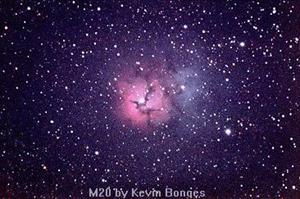Colorful DSOs
Jack Kramer
Marvel as you will at gorgeous color images of deep sky objects from the Hubble, observatories, and amateur astrophotographers, but visually you won't see these colors in your own telescope. Some members of the public are particularly disappointed when they look through our scopes because they expected something colorful. If those galaxies and nebulae really are that colorful, why don't we see them in Technicolor?
DSOs really do exhibit those colors, although some images are color-enhanced to better show the different wavelengths at which the objects radiate energy. But the human eye isn't nearly as sensitive to color as is a CCD chip, so it takes a lot of energy (bright light) to activate the color receptors in our eyes. At night in the dark, for example, it's much more difficult for us to make out colors. Our eyes are also more sensitive to the yellow-green part of the spectrum, and generally least sensitive to the red end - the very color that most emission nebulae radiate. So a red-emitting nebula will usually appear gray through a telescope. A CCD or film also has the ability to build up an image through long exposures. Our eyes sort of have that capability, called temporal summation, which allows them to respond like a long exposure causes film or a CCD chip to accumulate more light. Adjacent rods in the eye, each triggered by a photon, may send an en-masse nerve impulse that the individual rods would not have launched. But that still is insufficient to reveal much in the way of color in a DSO.
But all is not lost. There are a very few deep sky objects that radiate their light so strongly that even amateur-sized telescopes will allow our eyes to see some color. The odds are better when using a larger telescope because it gathers more light. Of course, many stars show distinctive colors. But beyond that, certain emission nebulae will reward observers who have normal color perception. Here are four of them.
M20 - Trifid Nebula in Sagittarius - The Trifid is both an emission and reflection nebula. The red color is from hydrogen that is set glowing by hot stars, very much like a fluorescent light bulb. The blue color is light from stars reflected off background nebulosity. The different colors show up well in LCAS member Kevin Bonges' photo of M20. Visually, this nebula is bright and in a dark sky looks very much like the photographs, except for the color. But the conditions on certain nights seem to be particularly conducive to showing color. My observing notes record that on at least two occasions I detected color in a 10-inch scope. Once from the New Mexico desert I saw a faint pinkish hue, and once from western Illinois the blue part of the nebula off to one side stood out particularly well.
 M42 - Great Nebula in Orion - Ionized by the hot young stars of the Trapezium, the hydrogen clouds glow particularly strong in the red band of the spectrum. Yet as bright and majestic as this nebula is, it seldom shows its colorful personality to the visual observer. But once from the Von Bergen farm in Hebron several of us saw a definite pinkish hue in Rich Burns' 13-inch reflector. More recently in my 12-inch a particularly bright section of the nebula showed a faintly peach-colored hue.
M42 - Great Nebula in Orion - Ionized by the hot young stars of the Trapezium, the hydrogen clouds glow particularly strong in the red band of the spectrum. Yet as bright and majestic as this nebula is, it seldom shows its colorful personality to the visual observer. But once from the Von Bergen farm in Hebron several of us saw a definite pinkish hue in Rich Burns' 13-inch reflector. More recently in my 12-inch a particularly bright section of the nebula showed a faintly peach-colored hue.
NGC 3242 - "Ghost of Jupiter" planetary nebula in Hydra - This appears as a perfectly circular nebula with a bright central disk and a somewhat fainter outer envelope. It's bright (magnitude 8.6) and displays a prominent blue-green color. Since it is so bright, it takes high magnification very well.
NGC 6905 - "Blue Flash" planetary nebula in Delphinus - This planetary is fainter at magnitude 12, yet it does show a slightly blue-green color. The surface brightness is uneven and a faint star embedded in the nebula popped in and out during prolonged observation with a 10-inch reflector.
There are other nebulae that may show some color, but the ones here are those in which I have definitely detected coloration. When it comes to diffuse emission nebulae, it seems as though a lot depends on atmospheric conditions because the effect varies from one night to another. Due to their strong radiation and compact size, planetary nebulae tend to be more consistent. (The light from galaxies is far too weak to visually show any color.) So when observing a bright nebula, you might want to be particularly on the lookout to discover if its energetic outpouring is sufficient to tickle the color receptors in your eyes.
Published in the April 2007 issue of the NightTimes




